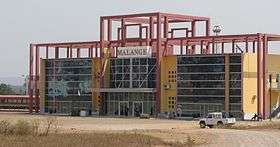Luanda Railway
| Luanda Railway | |||
|---|---|---|---|
|
Malanje station | |||
| Overview | |||
| Locale | Northwestern Angola | ||
| Termini |
Luanda Malanje | ||
| Technical | |||
| Line length | 424 km (263 mi) | ||
| Track gauge | 1,067 mm (3 ft 6 in) | ||
| |||
| CFL Luanda Bungo - Malanje | |||||||||||||||||||||||||||||||||||||||||||||||||||||||||||||||||||||||||||||||||||||||||||||||||||||||||||||||||||||||||||||||||||||||||||||||||||||||||||||||||||||||||||||||||||||||||||||||||||||||||||||||||||||||||||||||||||||||||||||||||||||||||||
|---|---|---|---|---|---|---|---|---|---|---|---|---|---|---|---|---|---|---|---|---|---|---|---|---|---|---|---|---|---|---|---|---|---|---|---|---|---|---|---|---|---|---|---|---|---|---|---|---|---|---|---|---|---|---|---|---|---|---|---|---|---|---|---|---|---|---|---|---|---|---|---|---|---|---|---|---|---|---|---|---|---|---|---|---|---|---|---|---|---|---|---|---|---|---|---|---|---|---|---|---|---|---|---|---|---|---|---|---|---|---|---|---|---|---|---|---|---|---|---|---|---|---|---|---|---|---|---|---|---|---|---|---|---|---|---|---|---|---|---|---|---|---|---|---|---|---|---|---|---|---|---|---|---|---|---|---|---|---|---|---|---|---|---|---|---|---|---|---|---|---|---|---|---|---|---|---|---|---|---|---|---|---|---|---|---|---|---|---|---|---|---|---|---|---|---|---|---|---|---|---|---|---|---|---|---|---|---|---|---|---|---|---|---|---|---|---|---|---|---|---|---|---|---|---|---|---|---|---|---|---|---|---|---|---|---|---|---|---|---|---|---|---|---|---|---|---|---|---|---|---|---|
Legend
| |||||||||||||||||||||||||||||||||||||||||||||||||||||||||||||||||||||||||||||||||||||||||||||||||||||||||||||||||||||||||||||||||||||||||||||||||||||||||||||||||||||||||||||||||||||||||||||||||||||||||||||||||||||||||||||||||||||||||||||||||||||||||||
The Luanda Railway (sometimes called Angola Railway) is a 424 km single-track Cape gauge railway line from the Angolan capital of Luanda to Malanje. A branch line departs the railway at Zenza do Itombe for Dondo. The line is operated by the state owned company Caminho de Ferro de Luanda E.P., short CFL EP.
History
From its terminal at the Atlantic port of Luanda, the railway heads inland towards Eastern Angola, but ends in the middle of the country at Malanje. A branch line departed the railway at Zenza do Itombe for Dondo.
The coastal segment from Luanda to Lucala was built by a Portuguese company in 1889. The line was then extended to Malanje in 1909 by the Portuguese government. After independence from Portugal in 1975, the Angolan civil war broke out. The prolonged fighting lasted until 2002 and destroyed most of the railway infrastructure in Angola.
In 2005, a $355 million rehabilitation project was begun by the China Railway 20 Bureau Group, with funding from the China International Fund. A total of 215 km of rails were rehabilitated, and another 264 km of new rails were laid. The project included the construction of 16 stations, 16 bridges, and 200 culverts. [1]
Resumption of services
In 2010, a passenger service resumed between Luanda and Malanje; Angola's Deputy Minister of Transport, José João Kuvingwa suggested that full operation could resume in 2011.[2][3] In July 2010, a twice-weekly freight service began, between Dondo and Luanda. In November 2010, CFL announced hourly passenger trains between Viana and Textang;[4] in December 2010, container services commenced, serving a dry port near Viana,[5] and in January 2011 the first train reached Malanje.[6]
The big majority of trains works the suburban stretch from Luanda to Viana and further to Catete. This service is carrying about 15 000 passengers per day as of 2015.[7]
Regular services Luanda - Malanje started in January 2011. One train per day is working the line, either up, i.e. from Luanda to Malanje, or down in the opposite direction.[8] The long distance trains start and end at Viana.
In Mid-July 2011, the CFL announced the introduction of electronic ticketing on an experimental basis for interprovincial journeys, beginning July 18.[9]
Accidents
In 2011, 34 people died from overall 70 accidents on the suburban stretch between the Luanda, Viana and Icolo e Bengo municipalities, most of them in cases where cars or people tried to cross the line at illegal crossings, said CFL marketing director Francisco Henriques to Angop.[10] After 18 years of interruption of railway traffic, there is a whole generation who has no experience at all with the difference of railway and automobile circulation.
On February 18, 2012, the rail line was interrupted for at least two days when a truck clashed with passenger train at a level crossing in the locality "Cabebeia", in município de Kambambe (provínce Kwanza Norte). The locomotive derailed completely, and also two railway cars were damaged.[11]
See also
- Benguela railway
- History of rail transport in Angola
- Moçâmedes Railway
- Rail transport in Angola
- Railway stations in Angola
- Template:Suburban railways in Africa
References
- ↑ "Angolan president speaks highly of China-built railway line on trial operation". Xinhua. 31 August 2008.
The Malanje-Luanda railway line with a contractual value of 355 million U.S. dollars is so far the largest infrastructural project China has contracted in Angola. ... It took three years for China Railway 20th Bureau to instruct some 4,300 local workers to complete the project which consists of laying 264-km-long new rails, revamping 215-km-long existing rails and constructing 16 railway stations, 16 steel and reinforced concrete bridges and over 200 culverts.
- ↑ "Railway Gazette: Angolan railway rehabilitation progress". Retrieved 2010-09-10.
- ↑ Railwaysafrica news
- ↑ "HOURLY TRAINS FOR CFL". Railways Africa. Retrieved 2010-11-14.
- ↑ "ANGOLAN RAILWAY SERVES DRY PORT". Railways Africa. 2010-12-12. Retrieved 2010-12-12.
- ↑ "FIRST TRAIN ARRIVES AT MALANJE". Railways Africa. Retrieved 2011-02-20.
- ↑ http://angola-luanda-pitigrili.com/who%E2%80%99s-who/j/julio-bango-joaquim
- ↑ Interview with CFL CEO Lobo de Nascimento in the weekly "O Pais"
- ↑ "Jornal de Angola: Bilhete electrónico vigora no comboio". Retrieved 2011-07-18.
- ↑ Acidentes ferroviários causaram mais de 30 mortes em Luanda em 2011 Article in Angop portal February 17, 2012
- ↑ Colisão entre comboio e camião corta circulação ferroviária Luanda/Malanje Article in Angop portal February 18, 2012

